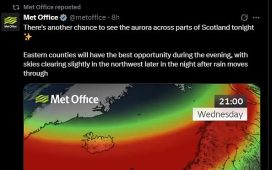Stunning time-lapse shared by ‘awestruck’ astronaut reveals the vastness of Earth’s atmosphere as seen from the International Space Station
- A video from the ISS captures a journey from the Pacific to the Atlantic Ocean
- The timelapse condenses 30 minutes into just one minute aboard the station
- Astronaut Nick Hague said he was ‘awestruck’ watching clouds disappear
A high-flying timelapse of the International Space Station sends viewers on a stunning trip from the Pacific Ocean to the Atlantic in just 60 seconds.
In the video taken by NASA astronaut Nick Hague, about 30 minutes of orbit time aboard the ISS — or a third of the time the station takes to complete one full rotation around the planet — takes place over just a minute, capturing the enormity of Earth’s atmosphere.
‘I was awestruck as I watched the wispy clouds disappear into the shadows,’ said Hague on Twitter.
Hague boarded the station on March 14 and is set to return from his six-month trip into space in October.
According to him, outside of the seemingly boundless beauty of Earth’s atmosphere, he has witnessed other, more personal, phenomenon during his time on the station.
‘[Two] months into my stay on [the ISS]! What’s it like adjusting to life in space? My back stretched out due to lack of gravity [and] I’m now [two] inches taller,’ reported Hague on Twitter.
‘Fluid shifts make me feel a bit stuffy, [and] the tops of my feet now have calluses since we use them like hands on handrails.’
Hague’s journey may be awe-inspiring from the vantage of the astronaut’s timelapse, but the mission’s attempted launch last year was anything but.


In the video, taken by NASA astronaut, Nick Hague, about 30 minutes of orbit time aboard the ISS — a third of the time the station takes to complete one full rotation around the planet — takes place over just a minute, capturing the enormity of Earth’s atmosphere

The ISS is currently home to Hague and several other astronauts who are conducting a range of experiments throughout the next several months
Last year, Hague and fellow astronaut Alexey Ovchinin had to abruptly eject from the rocket due to anomalies with the ship’s booster.
‘We were violently shaken side to side, thrust back into our seats as the launch escape system ripped us away from the rocket,’ said Hague in a NASA statement.
‘As all of that’s happening, you’re being shaken around, vision is blurry. I hear the alarm sounding and see the red light where the engine has had an emergency. I had the vivid realization we aren’t making it to orbit today, we’ve been pulled off rocket and we have to land.’
The astronauts tumbled back down through Earth’s atmosphere and escaped their harrowing trip safely without either of the astronauts being seriously harmed.
Over the next several months, the astronauts will conduct a range of experiments on the use of robotic assistants called Astrobees, advanced biomedical chips, and more.














